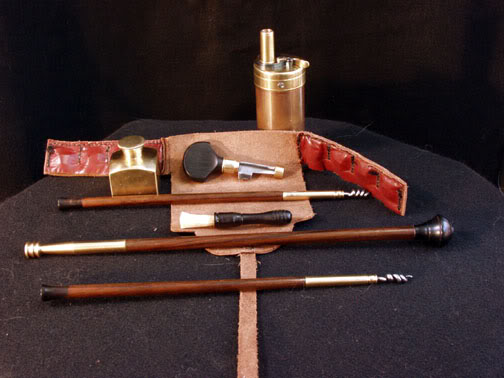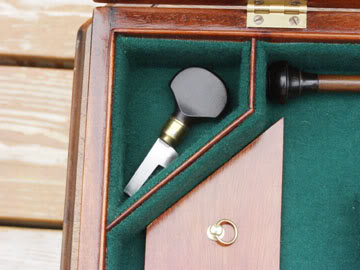- Joined
- Jul 4, 2020
- Messages
- 121
- Reaction score
- 59

I'll start.Can anyone identify these items for me?
Thanks!I'll start.
From the left
Stainless steel working rod for loading and cleaning.
Drop tube to deliver the powder directly to the breech without touching the barrel.
Volumetric powder measure with cut off funnel.
??? Could be a short starter but the shaft seems very small in diameter.
By the way, your box and the accessories look very nice.
Thanks! Sorry for the plexi and file size. It would make sense that with all the craftsmanship that was done the screws would have an orientation as you suggest. Both the John and Joseph Manton pistols have no respect for direction. That is not to say that other Manton pistols do have a proper screw orientation.I am impressed with the screw slots. It is really easy to twist a screw driver and mangle the screw.
To lay hands on a museum quality gun is more balls than I got.
The plexiglass rack has got to go. Would rather see if laid out in a white tablecloth.
The pictures were very important but if the photo file size was larger so I could zoom in that would be better.
Are you sure the screw slots orientation would have been any direction of the compass. I've worked on yachts that had the head of every screw lined up fore and aft. I kind of think if it had a platinum lined touch hole the screw slots would be extremely important.
I expect the experience of doing work on a pistol like this one is an accomplishment.
Congratulations on your work Tumbler.


Hi,
Here is a short tutorial about making correct case hooks for a pistol case using the Delft clay casting system.
https://americanlongrifles.org/forum/index.php?topic=4843.msg45540#msg45540
dave
Thanks for your help.I'll start.
From the left
Stainless steel working rod for loading and cleaning.
Drop tube to deliver the powder directly to the breech without touching the barrel.
Volumetric powder measure with cut off funnel.
??? Could be a short starter but the shaft seems very small in diameter.
By the way, your box and the accessories look very nice.
Thanks!I am impressed with the screw slots. It is really easy to twist a screw driver and mangle the screw.
To lay hands on a museum quality gun is more balls than I got.
The plexiglass rack has got to go. Would rather see if laid out in a white tablecloth.
The pictures were very important but if the photo file size was larger so I could zoom in that would be better.
Are you sure the screw slots orientation would have been any direction of the compass. I've worked on yachts that had the head of every screw lined up fore and aft. I kind of think if it had a platinum lined touch hole the screw slots would be extremely important.
I expect the experience of doing work on a pistol like this one is an accomplishment.
Congratulations on your work Tumbler.
Still deciding on the colors. Thanks.What the Deuce... no racing stripes???
Great looking Manton!
Thanks Dave.Hi Tumbler,
The black object is a handle that once held a turnscrew. The vent pick would slip over the blade and stick in a hole in the handle. Here is a photo of a modern example. Often the turnscrew blades were made from broken mainsprings as this one is.


dave
Enter your email address to join: